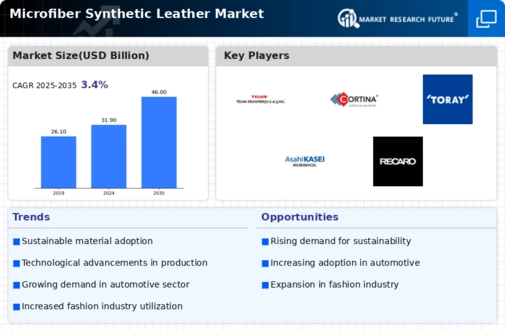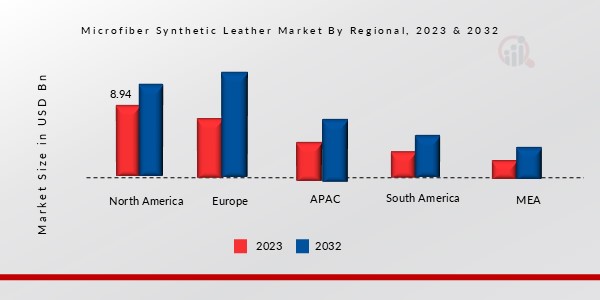Sustainability Trends
The Global Microfiber Synthetic Leather Market Industry is increasingly influenced by sustainability trends as consumers and manufacturers alike prioritize eco-friendly materials. Microfiber synthetic leather, often made from recycled materials, offers a more sustainable alternative to traditional leather. This shift is evident in the growing demand for products that minimize environmental impact. For instance, brands are adopting microfiber synthetic leather to align with consumer preferences for sustainable fashion. As a result, the market is projected to reach 31.9 USD Billion in 2024, reflecting a significant shift towards sustainable practices within the industry.
Fashion Industry Adoption
The fashion industry is a crucial driver of the Global Microfiber Synthetic Leather Market Industry, as designers and brands increasingly incorporate microfiber synthetic leather into their collections. This material allows for creative designs while addressing ethical concerns related to animal leather. The rise of vegan fashion has further propelled the adoption of microfiber synthetic leather, appealing to environmentally conscious consumers. As the fashion industry continues to embrace this material, the market is poised for growth, with projections suggesting a substantial increase in demand over the coming years, reflecting changing consumer preferences and industry standards.
Market Growth Projections
The Global Microfiber Synthetic Leather Market Industry is poised for substantial growth, with projections indicating a market value of 31.9 USD Billion in 2024 and an anticipated increase to 46.0 USD Billion by 2035. This growth trajectory suggests a compound annual growth rate of 3.38% from 2025 to 2035, reflecting the industry's resilience and adaptability to changing consumer preferences and market dynamics. The increasing adoption of microfiber synthetic leather across various sectors, including automotive and fashion, underscores the material's versatility and appeal, positioning it as a key player in the global market landscape.
Technological Advancements
Technological advancements play a pivotal role in the Global Microfiber Synthetic Leather Market Industry, enhancing product quality and performance. Innovations in manufacturing processes have led to the development of microfiber synthetic leather that closely resembles genuine leather while being more durable and easier to maintain. These advancements not only improve the aesthetic appeal of products but also expand their applications across various sectors, including automotive and fashion. As technology continues to evolve, the market is expected to grow, with projections indicating a rise to 46.0 USD Billion by 2035, highlighting the impact of technology on market dynamics.
Consumer Awareness and Preferences
Consumer awareness and preferences significantly influence the Global Microfiber Synthetic Leather Market Industry, as individuals become more informed about the benefits of microfiber synthetic leather compared to traditional leather. Factors such as durability, ease of maintenance, and ethical considerations are driving consumers towards microfiber alternatives. This shift in consumer behavior is evident in various sectors, including fashion and automotive, where brands are responding to the demand for sustainable and cruelty-free options. As awareness continues to grow, the market is likely to experience increased demand, contributing to its projected growth trajectory in the coming years.
Rising Demand in Automotive Sector
The automotive sector significantly drives the Global Microfiber Synthetic Leather Market Industry, as manufacturers increasingly opt for microfiber synthetic leather for vehicle interiors. This material offers advantages such as lightweight properties, durability, and ease of cleaning, making it an attractive choice for car manufacturers. As consumer preferences shift towards premium interiors, the demand for microfiber synthetic leather is expected to rise. This trend is reflected in the market's projected growth, with a compound annual growth rate of 3.38% anticipated from 2025 to 2035, indicating the automotive industry's pivotal role in shaping market dynamics.







